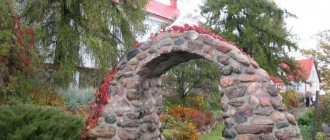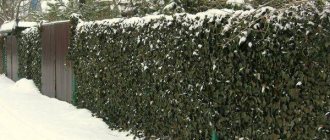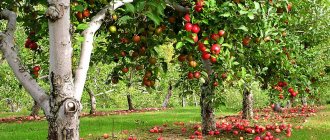Maiden grapes
There are different types of this beautiful woody vine. Most often in gardens you can see trellises entwined with Henry's maiden grape (also often called Chinese), five-leaf or ivy (also known as triacum, Japanese or Boston maiden grape).
This is a fast-growing vine that will fill the support with a lush carpet of bright, glossy foliage in the shortest possible time. The length of the vine varies depending on the species, but some plants exceed 10 meters.
Maiden grapes are an ideal plant for those who want to quickly cover a tall grape support with a beautiful vine that retains its spectacular appearance not only in summer, but also in autumn.
Clematis
Beautifully flowering vines that can withstand the harsh Far Eastern winters - the cat cried. I found this out by persistently burying non-local planting material. Of the clematis, Tangut clematis (Clematis tangutica), straight clematis (Clematis recta) and its purple form have survived.
Almost every winter, the above-ground parts of all of them froze, and they were restored from the roots. But they were restored regularly and even grew in width, increasing the diameter of the bush. I didn’t notice any pests or diseases on them.
Clematis directa grows straight, relatively thick stems up to 1.5 m from the root in a bunch; in mid-summer it is covered with a cloud of small fragrant flowers.
The purple form has very beautiful dark leaves set off by white flowers, which are noticeably less abundant.
Tangut clematis is all tender, airy and weightless. It has literally thread-like stems up to 3 m, the most elegant yellow bell-shaped flowers, and delicate fluffy fruit.
Out of ignorance, I planted Tangut clematis (grown from seeds) 3 meters from the girl’s grapes. While the clematis was growing and coming into force, the grapes mastered these three meters and the result was a kind of misalliance: the powerful dark green foliage of the grapes is illuminated by delicate yellow bells. The clematis foliage was not visible in the riot of grape greenery.
This option, as well as the combination of glossy foliage with fluffy clouds of fruit, seemed interesting to me, and I left everything as is. Unfortunately, the misalliance turned out to be unviable - after three years, the grapes strangled their partner.
Clematis recta. © Nikolina Tatyana
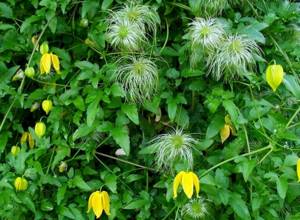
Tangut clematis (Clematis tangutica)
Schisandra chinensis
This climbing plant blooms for 1.5-2 weeks in late spring - early summer. Towards the end of flowering, the white flowers acquire a pinkish tint. But the vine reaches its real peak of beauty during the ripening of bright red fruits, which adorn the vine in large clusters.
Schisandra chinensis fully lives up to its name - this vine emits a strong citrus aroma. Is it any wonder that many summer residents are happy to add lemongrass leaves and bark to tea? Schisandra seeds and fruits are used for medicinal purposes as a tonic. Compotes, jelly, jams and preserves are also made from the berries.
It is worth considering that only young plants can easily tolerate full or partial shade, and with age, lemongrass requires more and more sunlight.
Used for making teas, soft drinks, jams, and also as medicinal raw materials
Shade and partial shade on the site

Many of the perennial flowers are, if not shade-loving, then shade-tolerant. For active growth and abundant flowering, it is enough for them to be illuminated by direct sunlight for only a few hours a day. It is best if it is in the morning, when the sun is not yet so hot, which means you don’t have to worry about “burns” appearing on the leaves.
It is much more difficult to select crops that can decorate those areas of the garden where there is no sun at all. Most often, such places are located under trees, which with their thick crown cover the soil surface from mid-spring to late autumn, preventing access to the sun. You can, of course, plant primroses and bulbous perennials (tulips, daffodils) here. They begin to grow in early spring and manage to bloom before they are covered by dense shade. But after 1.5-2 months, they will fade, the foliage will dry out, and weeds will begin to grow rapidly in their place. But you really want every, most remote corner of the garden or farmstead to look decorative throughout the entire spring-autumn season.
The greatest difficulties arise for those “landowners” who decided to create a small “forest” on their site. Flower beds, ridges, flower beds will look like foreign objects here, and it is not always possible to purchase a large number of expensive shade-loving perennials due to financial difficulties. At the same time, there is a fairly extensive “arsenal” of plants that grow quickly, covering vast areas. At the same time, many of them are unpretentious and do not require careful care or daily attention from the gardener.
Lunosemyannik
Only two varieties of this climbing plant are known: Daurian moonseed (or popularly called Dahurian ivy) and Canadian moonseed. Both species are suitable for growing in the middle zone, although the ovaries of the Daurian moonseed may fall off after frost.
This vine blooms with small white paniculate flowers in mid-summer. The fruits of the moonseed look juicy and appetizing, but, unfortunately, they cannot be eaten - they are toxic. If you often have small children at your summer cottage, it makes sense to plant only male plants to prevent pollination and the formation of ovaries.
In general, moonseed is easy to care for and decorative; this plant looks especially impressive when the vine is intertwined with trees and shrubs. During the season, the Daurian moonseed changes the color of the foliage from red to lemon, and the Canadian one - from rich green to bright yellow.
Ivy is perhaps the most traditional of all garden vines. It can be successfully grown both as a ground cover and as a climbing plant.
In Europe, the most commonly found plant is common ivy (English ivy). Colchis ivy and Pastukhov ivy also grow in the Caucasus.
This vine is not at all capricious, it winters well under snow cover, and does not “complain about its health” in the shady corners of the garden. Ivy is an evergreen plant, so it will decorate a gazebo, pergola or other support all year. What is important is that ivy can be safely allowed to “crawl” along the walls of the house - this plant, as a rule, does not harm buildings.
The fruits remain on the vine all winter and are food for birds
Favorite garden without hassle
Sometimes it is necessary to plant climbing plants . Not to hide from the sun, but, for example, to camouflage a fence or an old shed. There may be an unsightly view from the window of the house, which will be covered by a vine on an arch or pergola. There are several low-maintenance climbing plants suitable for a low-maintenance shady garden .
Aconite white-violet
Aconite white-violet
(Aconitum albo-violaceum) is a herbaceous climbing perennial up to 2.5 m long. The shoots die off in the winter, so they are removed in the fall.
The leaves are large and consist of 5 lobes. It blooms with inflorescences of white and purple flowers in August-September. Aconite climbing
Aconite climbing
(A. volubile) is a perennial herbaceous vine from 2 to 4 m long, with stems that die annually.
The leaves are dark green, shiny, palmate. It blooms in late July-August for about 50 days with dark blue flowers collected in very large inflorescences. Aconite arcuate
Aconite arcuate
(A.arcuatum) is a climbing herbaceous perennial 2.5 m long. Decorative all season with its leaves and light blue flowers. It blooms profusely and for a long time - from the end of July until frost.
The location for aconites should not be damp or low-lying, as their tuberous roots may rot. They can grow on any soil that is not dry, but they like fertile soil and are very responsive to fertilizing. Therefore, in the spring, be sure to feed them with complete mineral or organic fertilizer.
Maintenance is simple - watering in dry weather and, if the soil is not covered with mulch, weeding and loosening.
Actinidia kolomikta
Actinidia kolomikta
(Actinidia kolomikta) – liana up to 7 m tall. The medium-sized leaves change color throughout the season. When they bloom, they are bronze, then green; during flowering, the ends of the leaves become white, after flowering - bright pink, and by autumn crimson. And in the fall they are painted in various shades of yellow and crimson-red tones. It blooms with small white fragrant flowers in June for about 20 days. The fruits are green-striped cylindrical berries up to 2 cm long. They are edible and tasty, reminiscent of kiwi in taste.
Actinidia loves moist, fertile and non-alkaline soils. When planting, be sure to add a bucket of organic fertilizers (compost, humus).
Care consists of spring feeding with mineral or organic fertilizers from the second year after planting, watering during drought with 2 buckets per adult plant and mulching the soil with organic residues (leaves, sawdust, etc.). If it is necessary to prune branches that are in the way or thickening the crown, this should be done in late summer or autumn. Since in the spring the plant may die from excessive sap flow.
Tree pliers round-leaved
Tree pliers round-leaved
(Celastrus orbiculata) is a large vine up to 12 m long.
Young shoots are green. The leaves are round, dark green, shiny, orange-yellow in autumn. It blooms with inconspicuous greenish flowers in April. The capsule-shaped fruits with an orange-red bud ripen in mid-October and hang almost all winter. Tree pliers fruiting.
The location can be chosen either shady or sunny. The soil should be loose and fertile. When planting, wood pliers should be limited to a depth of 40 cm (along the perimeter of the hole), as it produces root shoots.
Care . In very dry weather, watering two buckets per plant is necessary. In the spring we feed the vine for the first 2-3 years after planting. In the fall, we mulch the soil with organic matter in a layer of 10-15 cm. It is also better to trim unnecessary branches in the fall, but it can also be done in the spring.
Clematis vinifolia
(Сlematis vitalba) - a vine up to 6 m long. The leaves are large, dark green. It blooms in August-September with small (up to 2.5 cm) creamy-white, slightly fragrant flowers collected in large inflorescences. In spring, the dead parts of the stems need to be cut off and the plant should be fed with complete mineral fertilizer. After this, the vine grows very quickly.
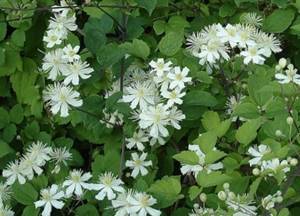
Very similar to the Lematis short-tailed
(S. brevicaudata). It has beautiful, very decorative leaves and blooms in September. Unlike clematis vinifolia, the stems of the short-tailed clematis overwinter well and do not need to be pruned.
Location and care are the same as for other climbing plants.
Common hop
Common hop
(Humulus lupulus) variety “Aurea” is a perennial vine up to 5 m long with shoots that die annually. The leaves are a very beautiful golden yellow color. When placed in full shade, where the sun does not reach, light green. It blooms with inconspicuous flowers in June - August, fruits - soft green "cones" about 5 cm long - adorn the plant from July to September.
The soil for hops needs to be fertile, preferably loam, with sufficient moisture, but not waterlogged.
The liana produces many root shoots, spreading very quickly beyond the area allocated to it. Therefore, when planting in a hole along the entire perimeter, you must immediately install a limiter to a depth of 30-40 cm.
The first couple of years it needs watering during the dry period and spring feeding. Then you can only get by with autumn mulching of the soil under the plant.
These are the climbing plants I recommend planting in the shady corners of your garden. Maybe you also have unpretentious vines growing that are not described in this article? Write in the comments.
If you liked the article, click on social networks.
Common hop
Common hops, unlike its fellow Japanese (or climbing) hops, have nothing against poor lighting and grow well in the shade. On the contrary, an excessive amount of sunlight is harmful to it and provokes the development of various diseases.
This plant can grow even in poor soils. However, it is worth considering that in fertile areas, hops can grow quickly, turning into a malicious weed that will not be easy to remove. Therefore, it is advisable to “settle” it away from beds and flower beds.
Hops are great for growing along chain-link mesh and unglazed gazebos. It forms a dense green carpet, reliably protecting from the wind and hiding the area from prying eyes.
The leaves and young shoots can be eaten; the cones are used in brewing and medicine.
If you were interested in this article, you might also like our selection of vines for sunny and semi-shady areas.
Climbing plants for the garden
To create coziness and as an elegant, sophisticated garden decoration, many gardeners choose climbing plants. They are used to decorate a personal plot:
- for decorating gazebos, pergolas, arches, fences, vertical surfaces of buildings;
- for creating a hedge (more details);
- to protect shade-loving plants in the garden;
- to attract insects that pollinate plants;
- for zoning the site.
Vertical gardening is popular among landscape designers to disguise unsightly areas or objects. Lianas on arched structures look organic and attractive when multi-colored inflorescences or fancy fruits hang from above.
Liana-like plants protect home gardens from prying eyes, dust and noise, and sunlight. Thanks to their rapid growth rates, they create unique compositions in a short time that do not require special care. These types of plants are popular due to two functions at once: decorativeness and practicality.
Perennial climbing plants for the garden
Practical gardeners seeking to minimize costs and care time prefer to plant perennial vines with a long lifespan. Decorative climbing plants for the garden, growing, form unusual compositions for many years.
Among perennial climbing plants, several ornamental varieties are especially popular:
- Clematis. Lianas with large flowers, up to 10 cm in diameter, in a wide variety of shades, are located on a support. They grow quickly and love bright sunlight. In winter, the vines are pruned and protected from frost with peat, agrofibre, fallen leaves, and straw.
Reference! Perennial vines are divided into 2 types: woody and herbaceous.
To save yourself from the hassle of growing climbing crops every year, you should choose unpretentious climbing perennial plants for your garden, which, as they grow, will provide you with an attractive appearance for many years.
Popular flowering vines and climbing garden plants
The modern floristic world offers a wide variety of climbing representatives for growing at home. All of them are distinguished by their original appearance, bright petals and shapes. We suggest considering the most popular perennial and annual climbing plants for the garden.
Variegated clematis
The ideal condition for growing clematis is a large amount of sunlight, as well as the presence of a support on which the above-ground part of the crop is located. In this case, the soil with the root system should be in slight shade. Clematis are afraid of severe frosts, so they must be pruned with the onset of November and covered with agrofibre, peat, and old fallen leaves.
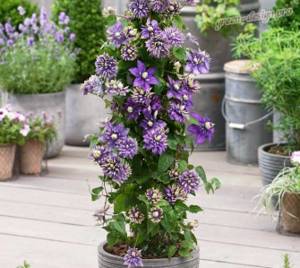
There are many types of clematis, they will delight you with the variety of shapes and colors of the petals.
The most decorative varieties are “Alenushka”, Maidwell Hall and Romantika.
Interesting climbing roses
Roses are a classic of the genre that will not leave anyone indifferent, enchanting with their pleasant aroma, tenderness and magical beauty. Thanks to the efforts of breeders, there is a huge variety of varieties that differ in interesting shapes and shades of petals.
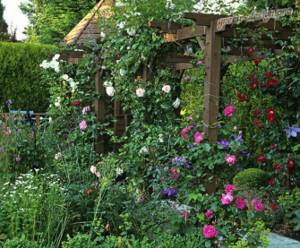
When growing such crops, you will definitely need holders for climbing plants in the garden to create harmonious compositions. There are 3 groups of climbing type roses:
- Semi-climbing. The height reaches up to 2-3 meters.
- Climbing. Maximum height – up to 5 meters.
- Curly. Height – up to 15 meters.
Almost all varieties of roses are frost-resistant, they are not afraid of various diseases and pests. They can be grown both in slight shade and in areas exposed to ultraviolet rays.
Gazebos decorated with rose bushes look very beautiful. You can use plants with the same petal color, making minimalist compositions, or create variegated duets from different flower color options.
Magic wisteria
Wisteria is another delightful representative of vines that forms extraordinary clusters, their length can reach up to 0.5 meters. When blooming, the brushes reveal white, lilac, and purple colors, effectively hanging down.

Chinese species of wisteria are able to withstand slight temperature drops, but in our conditions they are still grown as annuals. The only wisteria variety that can be successfully planted in our areas is Blue Moon. The variety is distinguished by lush blue flowering and resistance to temperatures down to -40°C.
Shade-loving climbing plants for the garden
For vertical gardening and creating coziness in secluded corners of the garden, plants that are not afraid of the lack of sunlight are perfect. Shade-loving vines are unpretentious, but at the same time they are just as decorative and attractive as other similar garden crops.
- Petiolate hydrangea. This rare species grows up to 20-25 meters in length. It is distinguished by its rapid growth rate and the ability to entwine any objects, even round ones. With insufficient sunlight, the color is slightly less, but they do not lose their attractiveness and aroma. This unpretentious variety of hydrangea is resistant to diseases and is practically not affected by pests.
Shade-loving crops are used for decoration in park areas with strong shading. Taking this feature into account, compositions are created in the garden, in the shade of houses and outbuildings.
Fast growing climbing plants for the garden
To obtain a decorative effect in a short time, gardeners choose fast-growing crops. Plants that cover vertical surfaces of 1-3 meters in 1-2 months. Among them there are annuals, which can be changed and replanted every season, and perennials, which do not require additional investment or care.
Such fast-growing crops can decorate the interior of a site and create a unique image in one season without much investment.
- Sweet pea. This annual plant of the legume family reproduces only by seeds. Reaches a length of 2-2.5 meters. Delicate thin vine-like stems are equipped with tendrils that, clinging, entwine around any obstacles. The plant is heat-loving and does not tolerate drafts. The shape and shade of the flowers differ from each other.
- Morning glory. Lianas with large leaves and flowers in the shape of a gramophone trumpet come in different shades. They open in the morning and close in the evening. Stems up to 5-6 meters long, with tendrils. Propagates by self-sowing.
Reference! Without active sunlight and proper care, the flowers of plants become smaller.
If desired, beautiful climbing plants for the garden can be planted every year, choosing those that suit your style and taste. Depending on the geographical location, the selection of fast growing crops differs in technical characteristics and method of cultivation.
Climbing frost-resistant roses
Rose "New Dawn"
The first one I got was “New Dawn” . And it fully confirmed all the declared characteristics, especially the thorniness of the shoots. Removing its shoots from the support, covering it for the winter, and then opening it and hanging it again is a form of hard labor.
Since it readily blooms on the shoots of the current year, which can grow up to 1.5 m in a season, after two years of torment I switched to short pre-winter pruning of the bush. She seems to have only gotten better: in the spring she begins to grow briskly from all the upper buds and in July blooms with semi-double pink flowers with a delicate scent.
It blooms and grows shoots until noticeable frosts. Never required treatment. If it weren't for its prickliness, it wouldn't have a price.
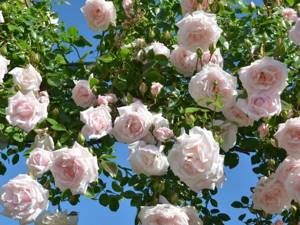
Rose "New Dawn". © davidaustinroses
Rose "Flamentanz"
“Flammentanz” also turned out to be able to survive the winter if the shoots were well covered. Since it blooms once and profusely on last year’s shoots, I had to learn how to preserve them. The biggest problem is not to break it when covering.
Dry wintering in the Khabarovsk Territory is not a problem: just as everything was frozen in early November, it will thaw only by April. Moreover, it does not melt wet, since the ground is frozen, but from above, under the sun, and is blown away by the wind.
The rose drives out lashes up to 2.5 m, blooms very profusely with double red-raspberry roses in July. The foliage is dark green glossy, there are noticeably fewer thorns than that of “New Dawn”, it also never required treatment, although sometimes gnawed leaves were found.
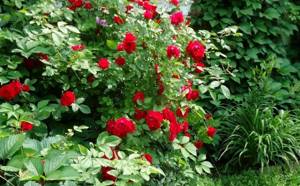
Rose "Flammentanz" © Nikolina Tatyana
Rose "Naema"
And what really surprised and pleased me was the rose “Nahema” . In the first year after spring planting, having seen it bloom and inhaled the aroma, I already agreed to build a personal greenhouse over it. It wasn't necessary. She is quite happy with the air-dry shelter and a half-meter layer of snow on top.
An amazing rose: it begins to bloom in June on overwintered shoots, producing graceful pink buds with a strong, delicate aroma in clusters.
When fully bloomed, the center shows, and the smell becomes stronger. It blooms all summer in waves on all growing shoots. The thorniness is even less than that of Flammentanz. In a ventilated, sunny place (and I provided her with the best!) it does not require any treatment. The only difficulty is with shelter - thick shoots are difficult to bend down. And you also need to secure them so that a thick layer of snow does not break them. However, this rose is not worth that much effort.
